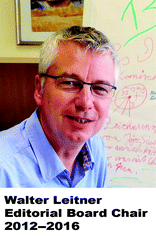Green Chemistry in 2017
Philip
Jessop
a and
Walter
Leitner
b
aDepartment of Chemistry, Queen's University, 90 Bader Lane, Kingston, ON, Canada K7L 3N6. E-mail: jessop@queensu.ca
bInstitut für Technische Chemie und Makromolekulare Chemie (ITMC), RWTH Aachen University, Worringerweg 1, 52056 Aachen, Germany. E-mail: leitner@itmc.rwth-aachen.de
Thoughts on Green Chemistry from the new Chair of the Editorial Board
Quo Vadis? Where are we going? That famous Latin expression comes to mind whenever I come to a metaphorical crossroads. Not only is this the time of a change in leadership at the journal Green Chemistry, but it is the start of our field's second quarter century. It's a time for reflection on the past and for a vision of the future. The past has been the childhood and adolescence of the field. Sure, we've had some growing pains, but our field has grown up. The journal too, under the brilliant leadership of Walter Leitner, has grown up to become a well respected and thriving research journal. That success means that a sudden change in direction for the journal is not warranted, but there is, as always, a need for a vision for the future. Where are we going? What will green chemistry look like 25 years from now?
In designing a green chemical, a product, or a process, a popular maxim is to “design for ideality”. Instead of tweaking the present version of a technology, envision what the technology would look like if it were ideal. This maxim is one of the design principles taught in both TRIZ and Six Sigma. Why couldn't this design principle be applied to the field of green chemistry? What would green chemistry research look like, if it was ideal? Here is my list of features that I imagine an ideal green chemistry research project would include:
• a clear identification of the old, incumbent technology that needs to be replaced,
• a new technology that has the potential to reduce environmental impact without sacrificing performance or economics,
• a consideration of many of the environmental impacts of the new technology and how they compare to the impacts of the old technology, and
• a forthright appraisal of the advantages and disadvantages of the new technology.
Such a realization of the advantages and disadvantages of a new technology, at an early stage in its research and development, would be powerfully effective in guiding further development. Realizing the disadvantages of a technology early on in its development is much better than discovering those disadvantages later, after most of the development is complete and the design is fixed in stone, or even worse – identifying disadvantages after the technology has already gone to market.
Too many new technologies, brought to market with the best of intentions to reduce environmental and health impacts, are found afterwards to have unintended harmful consequences. Tetrachloroethylene (“perc”) was introduced as a greener dry cleaning solvent to replace CCl4 and trichloroethylene, because of the carcinogenicity and toxicity of those earlier solvents, but after its adoption, “perc” was found to be carcinogenic as well. Similarly after acetone/hexane mixes were introduced as alternatives to perc in brake-pad cleaning sprays, formulators learned that acetone/hexane mixes are highly neurotoxic, an environmental problem that might have been discovered before going to market if their potential impact had been thoroughly considered. Unanticipated consequences are a major risk for green chemistry research and development, one that can only be avoided with frank and thorough appraisals of the advantages and disadvantages of every new technology. In the future, every green R&D project will include these considerations.
This is, of course, an ideality that we have not attained yet. There are many reasons why the above appraisals don't yet appear in many papers or conference presentations. Most researchers don't have the training and knowledge to be able to assess the impacts of new technologies and lack detailed knowledge of the impacts of incumbent technologies. However, as more students are trained in life cycle analysis and life cycle thinking, the skills required for assessing environmental impacts will become more common. For that reason, I have hope that one day such detailed appraisals will be a part of most green chemistry projects. Until that day, all of us who are developing new green chemistries should do what we can to consider possible impacts of our technologies, including educating ourselves on how to do impact assessment, or collaborating with people capable of such assessment. New software tools are being developed with the goal of making impact appraisal and predictions easier for everyone.
The field of green chemistry still has some growing to do. Fortunately, the field is already so strong that new ideas, new technologies, and new assessment methods are being published at an amazing rate. The path to the future, the path towards ideality, is getting clearer. The journal Green Chemistry will continue to serve the community, and I am delighted to be a part of that effort, as we walk along the path together.
Philip Jessop
Chair, Editorial Board
E-mail: jessop@queensu.ca
P. S. The above essay describes my vision of the future of the field of green chemistry. Many of you may have different ideas, I'm sure. If you feel inclined, please send me your vision of how green chemistry research will evolve. Also, please let me know how you think that the journal can best serve the community.
Setting the Sails for a Green Chemistry Horizon!
The year 2016 marked a special occasion for the field of Green Chemistry celebrating the “Silver Anniversary” of the core concept introduced by Paul Anastas and John Warner. At the same time, it is a very special year for me as my service as Chair of the Editorial Board ends following the policy of the Royal Society of Chemistry. As a catalysis researcher, I much appreciate the need for “turnover” and the concept of clearly defined terms of service is the best approach to ensure continuous development and progress. Despite the melancholy after such a long and wonderful collaboration, I thus consider myself one of the most fortunate chemists on the planet at the turn of the year. I am:
• tremendously glad and privileged to have been part of the journal’s success story
• extremely happy to see it in the safe hands of the excellent Editorial Board chaired by Phil Jessop with support by the Associate Editors C.-J. Li and Buxing Han
• hugely pleased to know about the professional and competent work of the Editorial Office in Cambridge by Anna Simpson, Katie Lim and their colleagues, and
• absolutely convinced that the field will flourish on the basis of the fundamental science and important applications reflected in the work of the authors and the reviewers.
If I look back at my 13 years of service, I really think this has been one of the most rewarding professional activities in my career. In the summer of 2003, I was approached by Colin Raston, then Chair of the Editorial Board, and Harp Minhas, then Managing Editor, with the idea of joining the Editorial Board in the role of “Scientific Editor”. This was a big surprise for me, as I had moved to RWTH Aachen not long before and I considered myself still in an early stage of my career (probably one of humans’ most frequent misconceptions: we always think we are “young” on a relative scale). I saw the footsteps of James Clark, the founding Scientific Editor and Roger Sheldon, the first Chair of the Board, and I was deeply humbled by this legacy. Colin, however, was very persuasive and after learning more about the excellent support by the Royal Society of Chemistry staff, I finally decided to join the gang. It sure was exciting times; the first impact factors were coming out and were in the range of 2–3 (quite high at these times), showing that the journal had made an excellent start. Papers were being submitted in rapidly rising numbers, and the Royal Society of Chemistry decided to move from 6 issues to 12 issues per year. In this situation, we discussed intensively in the Editorial Board about scope and quality standards and it was clear that we wanted to set the bar as high as possible. You may find a few very thin issues that are not bound square-back, but only stapled together from this period. Luckily, the strategy proved successful and the journal made its way to become one of the prime scientific periodicals in the chemical sciences with an impact factor of 8.5 resulting from two issues per month full of excellent science!
Taking off from the tracks laid out by the pioneers, the period between 2006 and 2012 saw a highly dynamic and most fruitful development. The collaboration with Sir Martyn Poliakoff as Chair was simply delightful and amazingly stimulating – I am very proud to say that we became “comrades” in this endeavor. Sarah Ruthven was the pivot, not only to the Royal Society of Chemistry, but also to the community by representing the journal at many international conferences and by coordinating the handling of a rapidly growing wave – almost a tsunami – of submissions. When Martyn’s term as Chair ended, I was highly flattered to be nominated his successor. In this period, the Royal Society of Chemistry re-organized its portfolio and organizational structure. The role of a “Scientific Editor” was replaced with Associate Editors, and the appointments of C.-J. Li in 2011 and Buxing Han in 2013 were yet another milestone in the journal’s development. The staff at Cambridge had to expand significantly to cope with the ever increasing popularity of the journal as a venue for the top chemistry research and Anna Simpson as Executive Editor (recently covered by Sam Keltie during her maternity leave) and Katie Lim as Deputy Editor became the main contact points for the community.
I am deeply grateful to have had the chance to collaborate with all these very enthusiastic, highly skilled, and most professional colleagues, co-workers and friends. It makes it extremely easy to say “farewell” to my role with this Editorial Board being in charge. Although it may not seem appropriate, I have to highlight the role of a single member here: Paul Anastas, who is a true friend and serious advisor and has shown such tremendous support for the journal, of course always perfectly balanced with his larger role as the mastermind and driving force of the field in general. With his team on board, the ship is setting strong sails for the Green Chemistry horizon! And I will of course not stay at the shore merely watching it go by; the research of my team will always be oriented according to the compass of the Green Chemistry principles. I am looking forward to contributing to the field with our science and to the journal with our most exciting results. My deepest respect and best wishes go to Phil as the next Chair, whom I learned to know as a most rigorous and sincere scientist ever since we edited the book “Chemical Synthesis in Supercritical Fluids” together back in the 1990’s.
With this very personal and admittedly quite emotional Editorial, I would like to say “Thank You” to the Green Chemistry journal and community.
It always seems impossible – until it’s done (Nelson Mandela)
Walter Leitner
| This journal is © The Royal Society of Chemistry 2017 |



